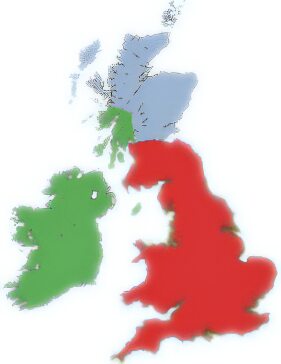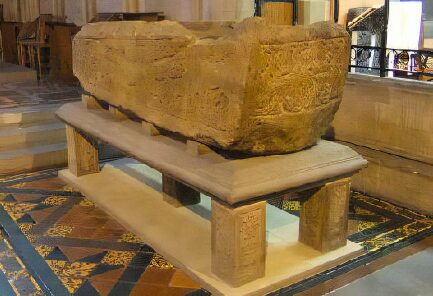Ystrad Clud
Strathclyde or Ystrad Clud (beautiful Estuary) was a kingdom of the Britons, or brythonic celts in the Hen Ogledd, in what is now Northern England and southern Scotland, through the post-Roman and medieval eras. The original occupants of the area were a Celtic tribe known as the Damnonii. The Scots referred to the kingdom of Ystrad Clud as Strathalcluith, and later Strathcluaide, which meant 'straddling' or 'crossing the Clyde'.
Scots, Picts and Britons
The kingdom emerged after Roman rule was withdrawn from Britain at the beginning of the fifth century. Its capital was Dumbarton Rock, a 240 feet high twin-peaked volcanic rock with the River Clyde on one side and the River Leven on two more, 'the Fortress of the Britons', known as Alt Clut in brythonic Celtic. A Celtic settlement on Dunbarton Rock was first recorded in a letter of St Patrick to King Ceretic, the British King of Strathclyde in about AD450. In which he complained about a raid the Britons had made on his Irish converts.
Strathclyde covered the area from Loch Lomond to the Celtic kingdom of Rheged around the Solway. At the head of Loch Lomond in Glen Falloch a great boulder, known as the Clach nam Breatann, the Stone of the Britons marked the northern reaches of Strathclyde.
It was bordered to the north by Pictland, to the north-east and east by the Goutodin, and to the south by Caer Guendoleu, and Galwyddel. the kingdom's southern region of Cumbria was acquired after the demise of North Rheged and acquired its name from its people, the Cymri, or comrades, from which same source the Welsh people referred to themselves as Cymru.
The Celtic peoples of Ystrad Clud were converted to Christianity in the fifth and sixth centuries. Missionaries from other parts of Britain, and Ireland, preached among them and baptised the kings of Alt Clut. Traditions assert that the earliest churches were founded by saints such as Kentigern, and Mirin or Mirren. The first church at Govan is said to have been established by St Constantine.
Language
The area's inhabitants spoke a P Celtic language known as Cumbric, which was closely related to the Old Welsh and Cornish languages. Cumbric lingered on in the western borderlands between England and Scotland until as late as the tenth century. Cumbric was once widely spoken throughout an area between the river Mersey and the Forth-Clyde isthmus, particularly in Cumbria, a region encompassing southern Scotland, and North England (Cumberland, Westmorland, parts of Northumberland, Lancashire and possibly North Yorkshire).
The evidence for Cumbric is derived through secondary sources since no contemporary written records of the language survive. The early poets Aneirin and Taliesin lived in Southern Scotland and composed their poems in Cumbric, but as the poems were passed down by oral tradition the versions which survived to the present are no longer in their Cumbric form but in early Welsh. Cumbric was eventually replaced by English and its Scottish variant - Lowland Scots. The Scottish lowland accent derives from Cumbric, which is why it is similar to Welsh.
Although now an extinct language, some farmers in Cumbria still count sheep using terms that derive from Cumbric - eg Yan, Tan, Tethera, Methera, Pimp compared to Old Welsh "Un, Dou, Tri, Petwar, Pimp". Evidence of the Cumbric language survives in the place-names of the far northwest of England and the South of Scotland, such as Lanark, deriving from rom the equivalent of Welsh llannerch 'a glade, clearing', Glasgow, from words equivalent to Welsh glas gau 'green hollow' and Penrith, Cumbria, meaning 'chief ford' (Welsh pen 'head; chief' and rhyd 'ford').
A few Cumbric words survived into the High Middle Ages in South West Scotland as legal terms in the Leges inter Brettos et Scottos ("Laws of the Britons and Scots") such as -galnes, galnys ('blood-fine'), kelchyn ('circuit'), mercheta ('marriage fee'). In Scots, a Cumbric speaker seems to have been called 'Wallace', from the Scots Wallis/Welsh.
There is currently a movement to revive Cumbric as a spoken language.
The Kings of Strathclyde
Many of the kings of Strathclyde and poorly recorded and are often known by the Welsh versions of their names. Ceredig, who lived in the fifth century was one of the first kings of Strathclyde. In the early seventh century Strathclyde was ruled by King Riderch I - Rhydderch Hael 'the Generous', who helped to introduce Christianity in Scotland by supporting St Kentigern ( St Mungo), the founder of Glasgow. Riderch, the son of Tutagual of Alt Clut, features in Welsh legend as the possessor of Dyrnwyn, a magical sword, one of the so-called Thirteen Treasures of the Island of Britain.
After the demise of Rhydderch, the Angles of Northumbria and the Scots of Dalriada dominated the north of Britain, but Owain, who reigned from 633-c45, restored the supremacy of Strathclyde with a decisive victory over the Scots at the battle of Strathcarron in 642, killing Domnall Brecc, King of Dalraida. A stanza of the ancient Welsh poem Y Gododdin refers to these events:-
'I saw an array that came from Pentir And bore themselves splendidly around the conflagration. I saw a second one, rapidly descending from their township, Who had risen at the word of the grandson of Nwython. I saw great sturdy men who came with the dawn, And the head of Dyfnwal Frych, ravens gnawed it.'
The Sack of Dumbarton Rock
Dumbarton Rock, capital of Strathclyde was sacked by a Viking army from Dublin led by the Viking chiefs known in Irish as Amlaíb Conung and Ímar, in 870. Duald MacFirbis recorded:-
Dunbarton Rock, scene of a Viking assault, image courtesy of Joe Porter
'In this year the kings of the Scandinavians besieged Strathclyde, in Britain. They were for four months besieging it; and at last, after reducing the people who were inside by hunger and thirst, they broke in upon them afterwards. And firstly, all the riches that were in it were taken; and also a great host was taken out of it into captivity.'
Many Britons were taken as slaves to Dublin. The king of Strathclyde Britons, Artgal map Dumnagual, managed to escape the destruction of Dumbarton, possibly by fleeing to the safety of Pictland; where he was later slain it was reported, 'on the counsel of Constantine'.
Following this defeat, the centre of Strathclyde was moved to Govan, near the confluence of the rivers Clyde and Kelvin, where a new political centre and royal stronghold was founded at Doomster Hill, around the church of St Constantine, on the southern bank of the Clyde.
Arthgal's son Rhun, the first king of Strathclyde to rule from Gowan, married his daughter to Kenneth macAlpine, King of Scots. Dyfnwal, probably the son of Rhun, ruled Strathclyde in the early tenth century. In 937, Owain I, King of Strathclyde, the son of Dyfnwal, was defeated along with his allies King Olaf III Guthfrithson of Dublin and Constantine II of Scotland, by the Anglo-Saxon King Athelstan of England at the Battle of Brunanburh referred to as 'the greatest single battle in Anglo-Saxon history before the Battle of Hastings'. Owain is believed to have been killed in the battle.
The Gowan Stones
Govan Old Parish Church in Glasgow occupies the site of the settlement of the Strathclyde Britons. A stepped earthen mound appears to have served as an assembly mound similar to Tynwald Hill at St John's on the Isle of Man.
The Church houses a collection of mostly intact early Christian tombstones marking royal burials of the Kings of Strathclyde, unearthed in the churchyard. Known as the Govan stones, they date from the ninth to the eleventh century, the collection of thirty-one monuments include five hogbacked, carved tombstones, which reflect Viking influence, and an elaborately carved stone coffin known as The Govan Sarcophagus.
The most ornate carving is featured on the sandstone tomb known as The Govan Sarcophagus which has been associated, though not proven, with St Constantine. There is also individual free-standing carved crosses and cross-slabs.
The most remarkable of the monuments are five hogback gravestones, carved with roof tiles and with stylised animal end pieces. These date from the mid to late tenth century and are the largest group known anywhere in Britain.
During the High Middle Ages, around the eleventh century, the area was conquered by the kingdom of Alba, becoming part of the new kingdom of Scotland. It remained a distinctive area until the twelfth century.
